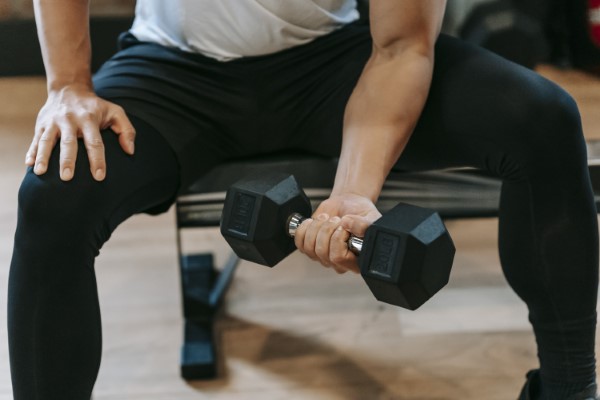
Photo by Andres Ayrton
ARE WE THERE YET?
Rarely, if ever, has any great empire or significant piece of art been completed solely in a day, and the same goes for you and your journey to reach your fitness goals.
Shaping the human body—for performance, physique or daily function—simply does not happen overnight. Though you may quickly begin to feel physical results in strength, movement skills and flexibility, concrete change takes a minimum of six weeks of consistent training. When it comes to changing you, it takes long-term consistency to see measurable results.
As you begin to learn exercise movements and increase weight, your body will naturally begin the adaptation process, becoming stronger and more able with each added stimulus. Typically, once an individual starts strength and performance training, the first attribute to see improvement is their strength. As training progresses, improvement will also begin to appear in the areas of muscle growth, respiratory capacity and speed. But the one unifying factor of measurable improvement is time. The longer you spend consistently training at regular intervals, the larger the measurable changes will be.
It is not unusual for an athlete to have trained consistently for thousands of hours over a number of years to become competitive in their sport at a high level. The same concept could be reasonably applied to general fitness as well. Staying strong and capable well beyond age 65 is not something you need to start thinking about six weeks before your 65th birthday. This is not to say that starting training later in life cannot or should not be done, but it is almost always easier to maintain strength and ability gained in youth than it is to develop those abilities as age becomes an obstacle.
After the first six to eight weeks of training, most people will show signs of improvement that are large enough to measure, but it is the consistency that will bring long-term results. Those who choose to spend their time and effort investing in their own health and abilities will reap the rewards as the months and years pass. Health and athletic performance are not built in a day, or a couple of weeks even, and those who wish to chase these goals should start now.
PLAN TO PERFORM
Let’s take a step back and look at the big picture. What is it that you are trying to achieve? What needs to happen for you to get there? What might be the stumbling blocks on the road to success that drag you down or stop your journey entirely? If you are looking to achieve something big in your life, whether it be in school, sports, work or anywhere else, these questions are a great place to start. They are part of a larger process of planning that needs to happen in order to have the best chance at achieving the goal you have set.
One of the best tools for breaking down a goal and creating a plan is called reverse engineering. Simply put, you lay out whatever it is you are trying to achieve. Then you look at where you are at and what you are doing now. Once we have good definitions for each of those, we can begin to work backward from where we want to be to where we are.
The differences between where you want to be and what you need to be doing compared to where you are now and what you currently do can then be divided by the amount of time you have. This will give you an idea of how big your steps need to be to reach your goal. More time and smaller obstacles typically allow for smaller steps, while less time and larger obstacles force you to take larger steps. Someone on a multi-year plan, for instance, can typically take rather small steps and still achieve success, while a six-month deadline forces a more dramatic line.
While working out, look critically at each step of the process, how large each individual step needs to be, and what might trip you up along the way. These stumbling blocks along the path can come in many forms, like injuries, sickness, local civil unrest or birthday cake. How can you address these issues when they arrive or avoid them through strategic planning? For example, a marathon runner might look to avoid injuries by taking a break from training at specific times of year. A cohesive plan needs to have these contingencies in place in order for it to work.
Now that we have an idea of where we want to be versus where we are, the scale of the steps which separate the two, and a plan to conquer each stumbling block along the way, put the plan into action. If you have done the work in planning, achieving a goal is as easy as following the plan.

Photo by Nappy
SPEED KILLS
In nearly every competitive sport the athlete or team who has a speed advantage has a significant edge. As you approach more elite levels of competition, the difference between scoring points or taking home a medal and coming away empty-handed can be as small as hundredths of a second. The question is: How does one go about getting faster?
It comes down to the development of multiple physical traits and abilities, followed by teaching the body how they all work together.
First and foremost among these attributes is strength. A solid base of strength is crucial if you are looking to achieve your top speed, because it sets the groundwork for everything else. Through strength the body gains the ability to push the ground harder and faster, creating longer strides and covering distance more efficiently. Interestingly, for the body to apply this newfound strength to running at top speed there must be increased body tension and control in the right places, which comes with the development of strength if the programming is correct. These factors work together toward applying more force into the ground; with greater force comes greater speed.
Beyond the development of strength comes the application of those new abilities. Training the body to apply force to the ground at greater speeds and teaching the body efficient patterns of movement both come together to produce the desired result. In most cases, these skills need to be taught and developed through careful training and specific practice before the teaching the body how they work in tandem.
Teaching your body how to bring all of these pieces of the puzzle together comes down to practice. If you want to get better at running at high speeds then you will need to run at high speeds. If everything else is done correctly to this point the body will begin to combine the strength and the skills developed to create the desired result—more speed and faster times.













